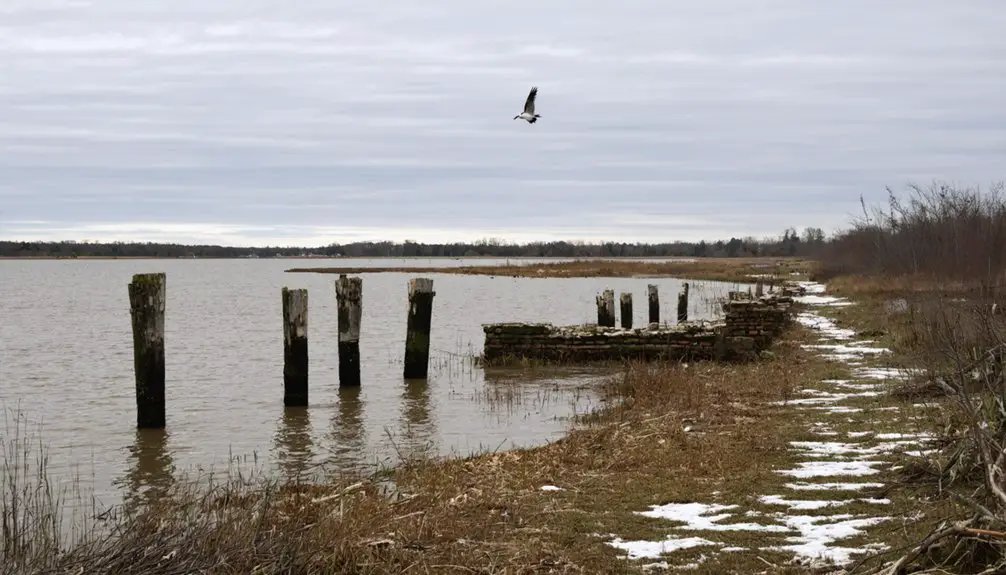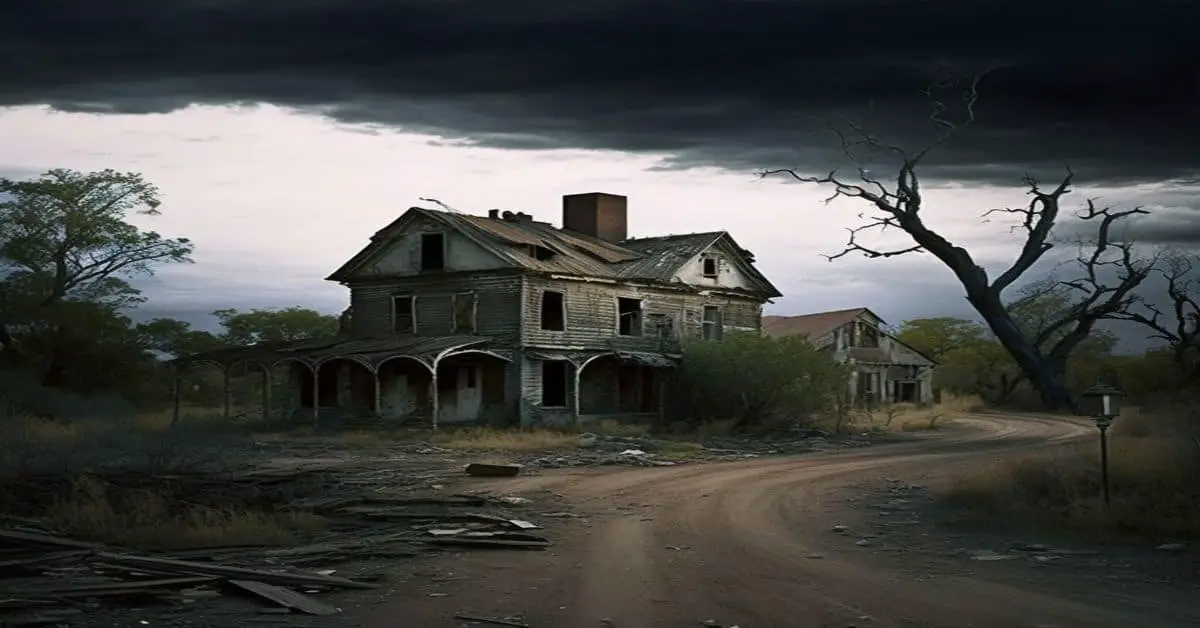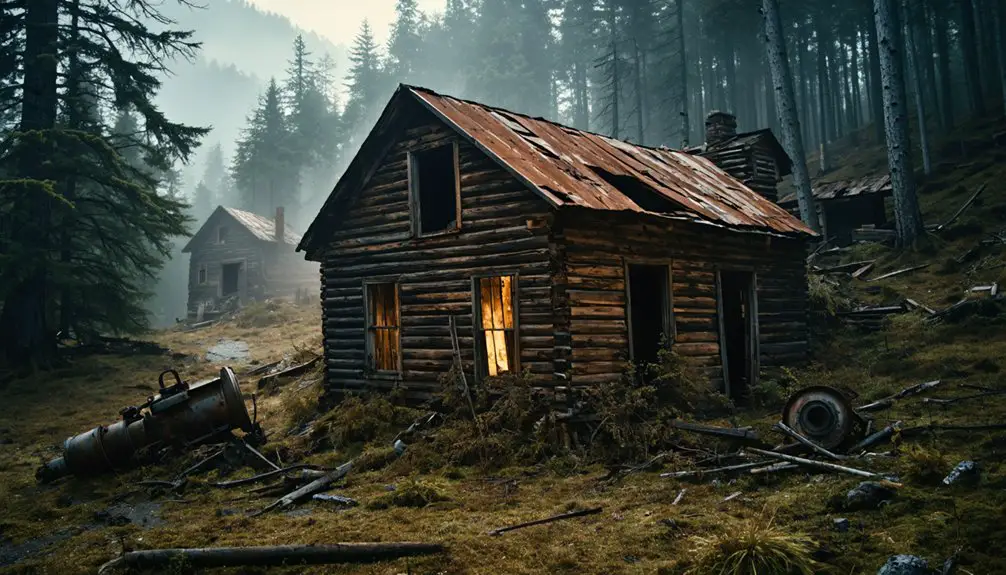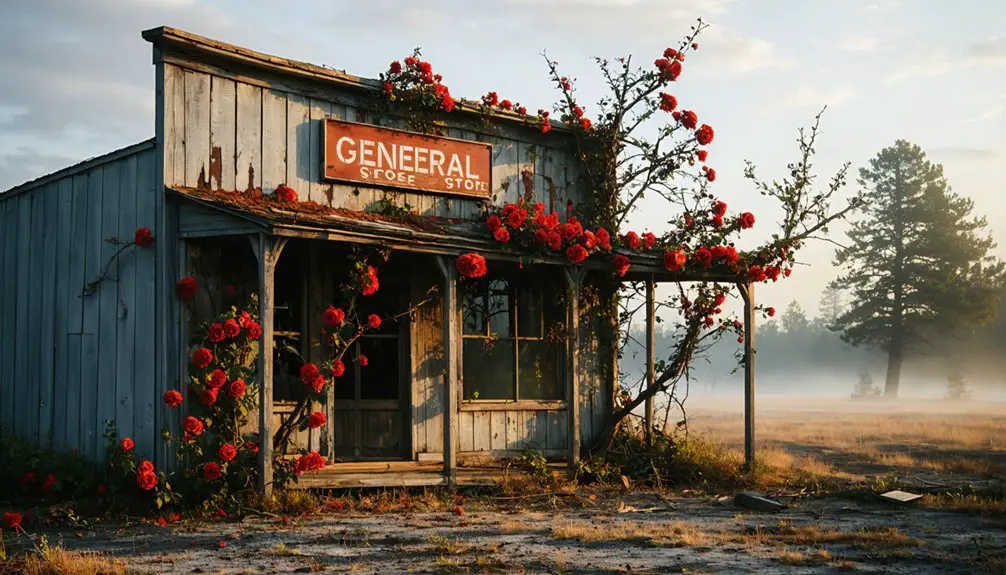You’ll find Sinepuxent’s ghostly remains near Assateague Island, where a once-bustling colonial port town thrived until the early 1800s. The settlement boasted the grand Rackliffe Plantation House and played a key role in Maryland’s tobacco trade before British naval raids during the War of 1812 struck heavy blows. A devastating hurricane in 1818 sealed the town’s fate, though local legends and mysterious tales still echo through its abandoned grounds.
Key Takeaways
- Sinepuxent was a thriving colonial port town on Maryland’s Eastern Shore until its decline in the early 19th century.
- A devastating hurricane in 1818 destroyed much of the port town, leading to the end of its maritime activities.
- The town suffered significant damage from British naval raids during the War of 1812, disrupting local commerce.
- Rackliffe House, a surviving landmark from colonial Sinepuxent, still stands and offers tours between May and October.
- Competition from larger ports, environmental challenges, and social instability following John Rackliffe’s murder contributed to the town’s abandonment.
Origins and Early Settlement of Sinepuxent Bay
While Native Americans had inhabited the Sinepuxent Bay area for roughly 10,000 years, permanent settlements didn’t emerge until around 900 A.D. when maize agriculture took root. The Pocomokes, Assateagues, and Chincoteagues established prehistoric settlements along the tributaries, building reed huts and developing sophisticated fishing practices using weirs to catch striped bass and shad. European diseases devastated these indigenous populations before most direct contact with settlers occurred.
You’ll find that native agriculture transformed the region’s character, as these Algonquin-speaking peoples cultivated the land while gathering nuts and tubers. This way of life continued until European exploration began, led by figures like Captain John Smith. By 1742, European settlement had largely displaced the native populations when Captain Charles Rackliffe constructed his grand estate overlooking the bay.
The Legacy of Rackliffe Plantation House
Standing as a tribute to colonial Maryland’s coastal heritage, the Rackliffe Plantation House has dominated its elevated ridge location since its construction between 1740-1752.
You’ll find remarkable historical architecture in its Flemish bond brickwork with glazed headers, steeply pitched roof, and strategic positioning overlooking Sinepuxent Bay and the Atlantic Ocean.
The plantation economy thrived on tobacco, corn, wheat, and livestock, with ten enslaved African-Americans working the 2,200-acre property by 1790.
Though the house endured the Revolutionary War, War of 1812, and Civil War, a devastating 1928 fire led to its decline. The Rackliffe House Trust established in 2004 led extensive restoration efforts to preserve this historic landmark.
Despite surviving three major American wars, the historic Rackliffe House fell victim to a destructive fire in 1928.
Visitors can explore the private group tours and educational demonstrations while enjoying scenic views of Assateague Island.
Today, you can visit this restored colonial landmark from May through October, where it stands as one of Maryland’s Eastern Shore’s rare surviving examples of 18th-century coastal plantation life.
Military Conflicts and Historical Events
You’ll find Sinepuxent’s most turbulent period during the War of 1812, when British naval forces conducted aggressive raids along Maryland’s coast.
The region’s strategic location and privateering activities had earlier drawn British attacks in 1778, when HMS Mermaid and the galley Firefly targeted local maritime operations.
Notable American naval hero Stephen Decatur was born in Sinepuxent before becoming the youngest captain in U.S. Navy history.
The area’s militia maintained cannon batteries to defend against these threats, though their effectiveness was limited by the surprise nature of many British assaults.
A devastating hurricane in 1818 sealed Sinepuxent, permanently destroying the once-thriving port town and its maritime activities.
War of 1812 Raids
During the War of 1812, Southern Maryland and the Chesapeake region endured the heaviest concentration of British raids and military operations in the state.
The British tactics included burning towns like St. Leonard, Rock Hall, and looting Chaptico, while conducting operations from strategic points like Queenstown. In August 1814, you’d have witnessed Major General Ross landing 4,500 troops at Benedict – the largest British naval force to enter Southern Maryland waters. The First and Second Battles at St. Leonard Creek marked Maryland’s most significant naval engagements. Rear Admiral Cockburn commanded the British fleet that faced minimal resistance in 1813.
American resilience emerged through the Chesapeake Bay Flotilla‘s determined resistance, as they delayed British advances up the Patuxent River for three months.
Despite ultimately destroying their own vessels to prevent capture, these naval forces later joined the defense of Washington, D.C., demonstrating the Americans’ fierce commitment to protecting their homeland against foreign invasion.
As the spring of 1778 approached, British naval forces launched aggressive raids against Sinepuxent and nearby Chincoteague to suppress American privateering activities.
Captain Timothy Hall, commanding HMS Mermaid with 28 guns and accompanied by the galley Firefly, received orders to destroy these coastal communities “to their foundations” for harboring privateers who disrupted British control.
The British blockades targeted strategic inlets along Maryland’s coast, aiming to crush the privateering strategies that threatened their supply lines. Much like their later defeat of HMS Macedonian in 1812, American naval forces would eventually prove formidable against British warships. Drawing lessons from Japanese kamikaze tactics during World War II, naval warfare would continue to evolve through innovative attack strategies.
You’ll find that British ships maintained a tight grip on maritime traffic, while American vessels like the “Swallow” continued to challenge their dominance.
The raids reflected Britain’s determination to maintain naval superiority, leading them to systematically dismantle resistance points and privateer havens along Maryland’s shoreline.
Colonial Defense Efforts
While British naval forces threatened Maryland’s coastline, local colonists organized robust militia units to defend Sinepuxent Inlet and the surrounding region.
Their militia strategies focused on protecting essential waterways and maintaining control of the strategic inlet, which proved indispensable for both commerce and military operations.
- Local militias guarded against British incursions while supporting Continental Army operations
- Farms near Sinepuxent provided critical food supplies to Revolutionary forces
- Salt production facilities helped preserve wartime provisions
- Coastal fortifications and defense tactics included blocking harbor entrances
- Strategic control of Sinepuxent Inlet enabled monitoring of enemy naval movements
You’ll find that these defense efforts extended beyond the Revolutionary War into the War of 1812, when local forces continued protecting the region from British raids and maintaining vigilance over this significant coastal area.
Tales of Haunting and Local Legends

You’ll find three powerful ghost stories that persist from Sinepuxent’s colonial history: a grieving widow who took her life in Rackliffe House‘s attic after British forces conscripted her son, a well-dressed lady who met her end falling down the mansion’s grand staircase during a ball, and the vengeful spirits of slaves who murdered their cruel master John Rackliffe.
Each tale interweaves documented historical events with supernatural elements, from the wartime British occupation to the dark realities of plantation life at Rackliffe House.
Colonial Widow’s Last Night
Deep within the haunting lore of Sinepuxent stands the tragic tale of a colonial widow’s final moments at Rackliffe Plantation.
You’ll find whispers of her spectral presence in the brick mansion built in the 1740s, where the widow’s fate was sealed during what should have been a festive evening.
- A lady, dressed elegantly for a ball, tumbled down the stairs to her death
- Local tradition suggests she might’ve been Sara Rackliffe, who left behind four orphaned children
- Her spirit is said to linger in the house, a reflection of colonial-era hardships
- The tragedy occurred shortly after her husband John’s death
- Her story intertwines with the plantation’s darker history of slavery and loss
The widow’s tale echoes through generations, reminding you of life’s fragility in 18th century Maryland.
Dancing Lady’s Fatal Fall
The haunting legacy of Sinepuxent’s Dancing Lady emerges from the same brick mansion where the colonial widow met her end.
You’ll find her tale intertwined with the Rackliffe Plantation’s history, where the “Sandy Point Dancing Floor” once bounced with celebration. Among the tragic legends that haunt these grounds, none captivate quite like the mysterious woman who fell to her death during a grand ball.
Some whisper she’s Sara Rackliffe, while others claim she’s an unidentified guest.
Either way, one of Maryland’s most compelling dancing ghosts still seeks directions to the long-destroyed Graham Springs Hotel. Her anonymous grave bears a solemn warning: “UNKNOWN – Hallowed and Hushed be the place of the dead. Step Softly. Bow Head.”
When you visit at night, you might catch her ethereal form, forever bound to that fatal fall.
Slaves’ Revenge Lives On
While many ghost stories from Sinepuxent’s Rackliffe House focus on tragic accidents, none carry more historical weight than the documented murder of plantation owner John Rackliffe by his enslaved workers.
This act of slave resistance echoes through time in local legends and paranormal tales that continue to haunt the 1,700-acre former plantation.
You’ll find these haunting reminders of the past throughout the property:
- Spectral sightings near the slave quarters and work areas
- Unexplained sounds from the attic where a woman reportedly hung herself
- Strange occurrences near the old tobacco fields
- Ghostly figures spotted along the former salt-making grounds
- Mysterious activities in areas where archaeological evidence shows slave presence
These stories serve as powerful reminders of those who fought against their bondage, their spirits seemingly refusing to rest in a place where they once toiled in captivity.
Life on a Colonial Tobacco Estate
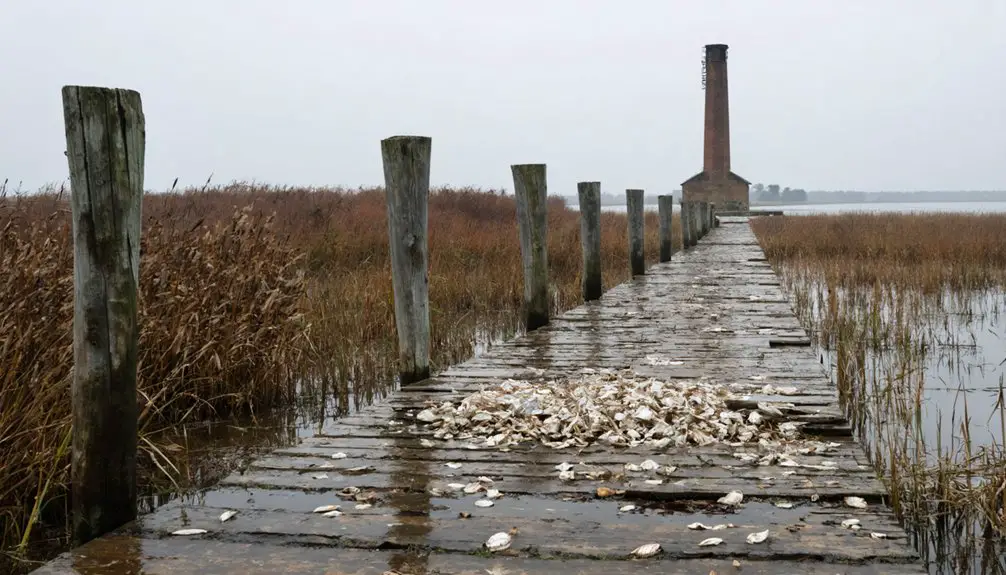
During Maryland’s colonial period, life on tobacco estates revolved around the demanding cultivation cycle that shaped everyone’s daily existence. You’d find the year’s work beginning in late winter with seed sowing, followed by June transplanting into carefully arranged tobacco hills.
The relentless tobacco cycle dictated colonial Maryland life, from winter seed sowing through summer’s careful transplanting into neat rows.
The summer months required constant attention – weeding, hoeing, and protecting plants from pests.
If you’d visited these estates, you’d have witnessed a stark social hierarchy. While wealthy plantation owners lived in grand houses near their private wharves, the backbreaking labor fell to indentured servants and, increasingly by the 1700s, enslaved workers.
The tobacco cultivation demanded massive workforces, depleted the soil rapidly, and forced continual forest clearing for fresh land. This intensive agricultural system created deep social divisions while making plantation owners increasingly dependent on enslaved labor to maintain their profitable enterprises.
From Thriving Port to Abandoned Settlement
Originally granted as a 2,200-acre tract called Genezeer in 1679, Sinepuxent flourished into a bustling colonial port town centered around the stately Rackliffe House.
The coastal economy thrived on tobacco exports and historical commerce with British traders, making it an essential hub for maritime trade and social gatherings.
You’ll find these key factors led to its decline:
- British naval attacks during the War of 1812 disrupted local commerce
- Murder of John Rackliffe by enslaved people sparked social instability
- Devastating fire in 1929 gutted the main house
- Environmental challenges from storms and shoreline erosion
- Competition from larger, more accessible ports reduced economic viability
Preserving Maryland’s Eastern Shore History
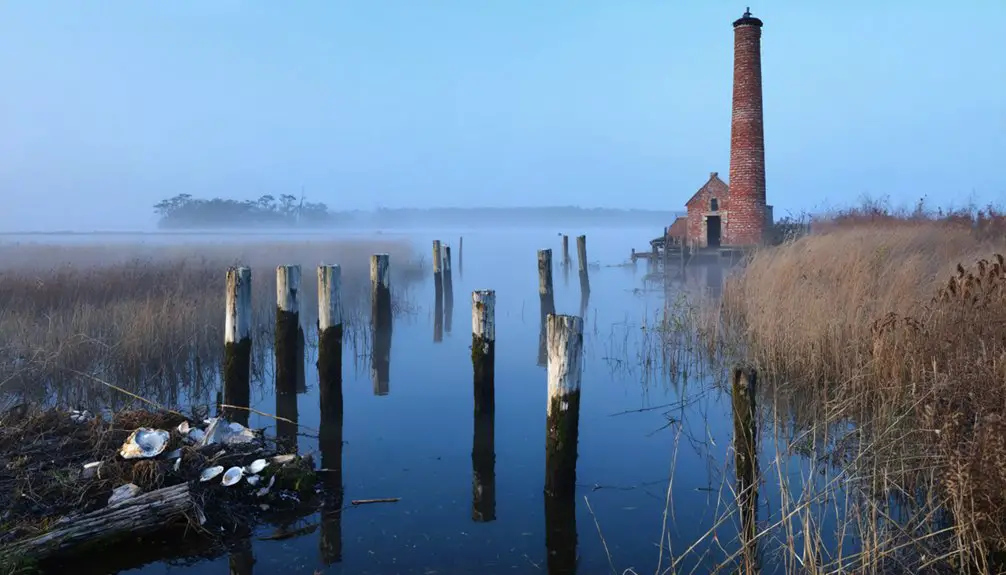
Despite Sinepuxent’s decline, modern preservation efforts on Maryland’s Eastern Shore work to protect similar historic places from meeting the same fate.
You’ll find organizations like Preservation Maryland leading initiatives to revitalize historic communities while addressing modern challenges like climate change impacts on aging structures. The Bartus Trew Providence Preservation Fund offers grants up to $25,000 for local historic preservation projects, helping communities maintain their cultural heritage.
Community engagement plays a crucial role through volunteer groups that manage sites like Malone’s Church, which maintains connections to Harriet Tubman’s family.
Local volunteers preserve sites like historic Malone’s Church, keeping alive vital connections to freedom fighter Harriet Tubman’s family heritage.
You can explore this history through Shore History’s educational programs and exhibits at National Historic Landmark sites, where they’re keeping Eastern Shore heritage alive through rotating exhibitions and multi-generational learning opportunities.
Frequently Asked Questions
What Happened to Sinepuxent’s Original Native American Inhabitants After Colonial Settlement?
Picture native fires dimming as you’d witness their forced cultural assimilation and land displacement, with tribes relocating to Snow Hill’s reservation, joining northern Iroquois, or moving west with Delaware and Cherokee peoples.
How Did Local Weather Patterns and Natural Disasters Affect Sinepuxent’s Development?
You’ll find that Atlantic storms, hurricanes, and rising sea levels severely limited development, while poor climate impact resilience and slow disaster recovery ultimately contributed to the settlement’s decline and abandonment.
Were There Any Documented Escapes From Slavery at Rackliffe Plantation?
You won’t find documented slave escapes from Rackliffe Plantation in primary sources, though the violent murder of John Rackliffe by enslaved people shows resistance existed against brutal plantation conditions.
What Transportation Routes Connected Sinepuxent to Other Colonial Settlements?
Through 18th-century ferry crossings that served 100+ vessels monthly, you’d find colonial trade routes connecting Sinepuxent via Chesapeake Bay waterways, coastal inlets, and wagon roads to Baltimore, Annapolis, and Philadelphia.
How Many Families Lived in Sinepuxent During Its Peak Population?
You can’t pinpoint exact family demographics, but historical patterns suggest the peak settlement likely supported between 20-50 families, given its role as a small coastal shipping village.
References
- https://shorebread.com/2011/10/17/haunted-history-beyond-the-folklore-true-stories-of-the-rackliffe-house/
- https://m.ocean-city.com/the-eastern-shores-haunted-history-and-resident-ghosts/
- https://shorebread.com/2012/10/23/rackliffe-plantation-house-coastal-jewel-restored-to-former-glory-but-is-it-still-haunted/
- https://en.wikipedia.org/wiki/Rackliffe_House_(Assateague_State_Park)
- https://en.wikipedia.org/wiki/List_of_ghost_towns_in_Maryland
- https://dnr.maryland.gov/waters/coastalbays/documents/ch2.1.pdf
- https://worcesterlibrary.org/sites/default/files/documents/worcester_county_history.pdf
- https://www.jamesflee.com/blog/rackliffe-house
- https://en.wikipedia.org/wiki/History_of_Maryland
- https://www.beach-net.com/delaware-maryland-beach-towns/ocean-city-maryland-history.php
